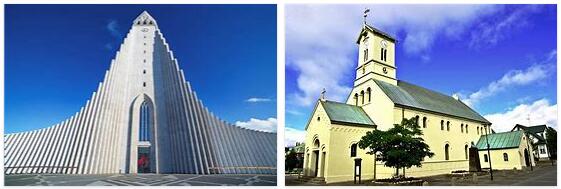Architecture. – Country with a very advanced architectural culture, Iceland it has been severely hit by the global economic crisis and its construction production has certainly been affected. Traditionally influenced by its climatic exceptionality, as well as by the Scandinavian design culture, Icelandic architecture is at the same time among the most open to international influences, especially in major cities such as Reykjavík and Kópavogur, where the first large-scale projects and first towers. An interesting example is the Smáratorg office tower (2008), in Kópavogur, designed by ARKÍS, the tallest in the country; significant, also from a dimensional point of view, is the Höfðatorg complex in Reykjavík by PK Arkitektar, completed in 2009, in full crisis:urban skyline anything but homogeneous. In 2010 they are the B25 House by PK Arkitektar in Reykjavík and the headquarters of the Reykjavík University of ARKÍS with the Danish studio Henning Larsen Architects.
Inaugurated in 2011: the Harpa Concert hall & Conference Center in Reykjavík, the work of the aforementioned Henning Larsen Architects; the reconstruction of the historic building of Nyja Bíó, designed by Studio Granda; the Ice House of Minarc, again in Reykjavík.
Many new, qualified projects have also been carried out outside the capital. Among the most interesting examples are: the Botanical gardens cafe (2013) of Kollgáta arkitektúr in Akureyri; the Ion Hotel (2013) in Minarc inside the Thingvellir national park; the Stöðin service area (2012) of Krads in Borgarnes; the Hofsos swimming pool (2010) by Basalt Architects; PK Arkitektar’s house in Árborg (2010); the Culture Center (2010) of Arkitema Architects in Akureyri; the Business School (2005) of Studio Granda in Bifröst; by ARKÍS Architects: the Villa Lóla (2010) in Akureyri, the headquarters of the Icelandic Institute of natural history (2010) in Gardabær, the Snæfells stofa visitor center (2010) in Egilsstaðir.
Cinema. – Icelandic cinematography only released in 1948, four years after independence from Denmark, the first sound and color film, Milli fjalls og fjöru (Between the mountain and the beach), directed by the pioneer Loftur Gudmundsson. Between the 1950s and 1970s, Óskar Gíslason, also in the field of production, and Reynir Oddsson were key figures. In 1980 Friðrik Þór Friðriksson made his debut, a filmmaker and producer who gave a decisive turning point to Icelandic cinema. His Börn náttúrunnar (1991, Children of Nature) was the only Icelandic film to be nominated for an Oscar.
Throughout its history, the cinema of the Iceland he told intimate stories and legends, life in the capital Reykjavík and the spaces of the countryside to always elaborate a reflection on identity. In recent years, established directors and new authors have contributed to the growth of this cinematography. In 2000 Baltasar Kormákur made his debut, whose filmography alternates films shot in Iceland and in the United States. Original author, Kormákur has explored various genres: urban tragicomedy in 101 Reykjavík (2000), family tragedy in Hafið (2002, The Sea), thriller in his first international production A little trip to heaven (2005), the action in Contraband (2012) e 2 guns (2013; Loose dogs). Notable was the first work by Dagur Kári Nói Albinói (2003, We the albino), while among the works of Hilmar Oddsson it is worth mentioning Kaldaljós (2004, Cold light), whose protagonist is a man tormented by feelings of guilt . Friðriksson confirmed his poetic research with Næsland (2004, known as Niceland) and with the television series Tími nornarinnar (2011, Season of the Witch). The Nordic sagas instead inspired Sturla Gunnarsson for the blockbuster Bjólfskviða (2005, known as Beowulf and Grendel).
Hafsteinn Gunnar Sigurðsson recounted the friendship between two men in the unusual road movie Á annan veg (2011, Another road) and family relationships in the dramatic comedy París norðursins (2014, known as Paris of the North); Ragnar Bragason with Málmhaus (2013, known as Metalhead) has built an original interweaving between tradition and metal music; Benedikt Erlingsson with Hross í oss (2013, Of horses and men) has signed a surprising debut feature which traces, with fairytale-like humor and nuances, the relationship existing in Iceland between humans and horses; Grímur Hákonarson with Hrútar (2015, Pecore) described loneliness, incommunicability, wild nature intertwining realism, humor and challenges reminiscent of the western.
Also worthy of mention are the filmographies of two stateless filmmakers, Róska and Sólveig Anspach. Róska (RagnhildurÓskarsdóttir, 1940-1996), militant artist, lived for a long time in Italy, where in 1969 he directed, with Dominique Isquermann and Manrico Pavolettoni, the experimental film The impossibility of acting Elettra today and in Iceland he made together with Pavolettoni Sóley (1982), works on freedom and oppression. Anspach was the author of documentaries and fiction films in Iceland, France, United States.
